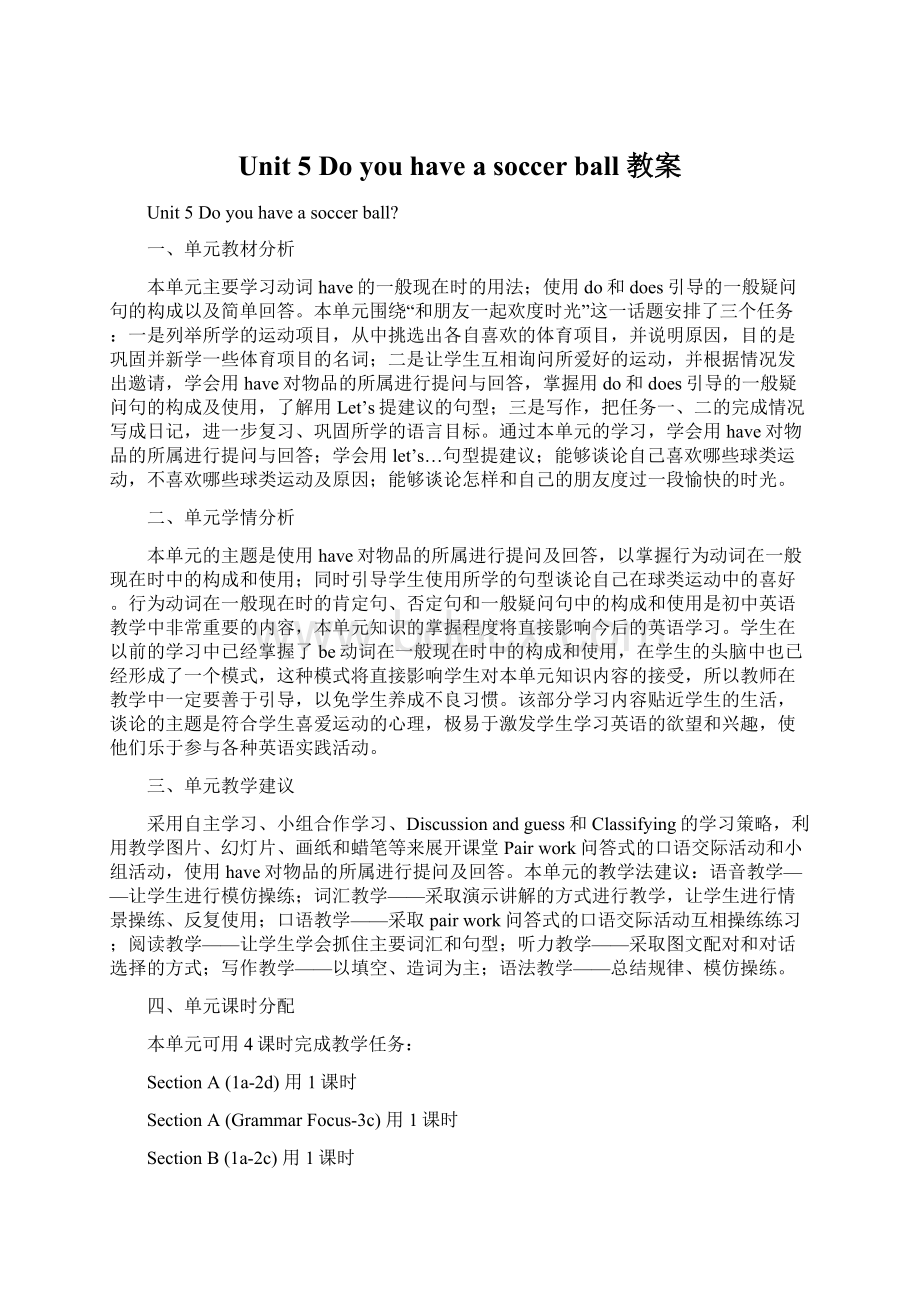Unit 5 Do you have a soccer ball 教案Word文档格式.docx
《Unit 5 Do you have a soccer ball 教案Word文档格式.docx》由会员分享,可在线阅读,更多相关《Unit 5 Do you have a soccer ball 教案Word文档格式.docx(17页珍藏版)》请在冰豆网上搜索。

SectionB(3a-SelfCheck)用1课时
SectionA1(1a-2d)
一、教学目标:
1.语言知识目标:
1)能掌握下列词汇:
do(does),have,tennis,ball,ping-pong,bat,soccer,soccerball,basketball,let,us,let'
sgo,we,late,has,get
2)学会用have对物品的所属进行提问以及应答,学会使用do和does引导的一般疑问句:
①—Doyouhaveabaseball?
—Yes,Ido./No,Idon'
t.
②—Doesshe/hehaveatennisball?
—Yes,she/hedoes./No,she/hedoesn'
t.
③—Dotheyhaveasoccerball?
—Yes,theydo./No,theydon'
3)学会用Let’s…提建议。
2.情感态度价值观目标:
利用学生喜爱运动的心理,激发学生学习英语的欲望和兴趣,使他们乐于参与各种英语实践活动。
在小组活动中,培养学生团结协作精神。
二、教学重难点
1.教学重点:
1)通过运用have对物品的所属进行提问以及应答,来掌握一些运动项目的词汇。
2)在询问对方是否有某物的对话中学会使用do和does引导的一般疑问句。
3)学会用祈使句来向对方提出建议。
2.教学难点:
学会使用第三人称单数的一般疑问句Does…?
及回答做对话。
三、教学过程
Ⅰ.Presentation
1.Presentthekeyvocabulary.
(Showabasketballtotheclass.)
T:
What’sthisinEnglish?
S1:
It’sabasketball.
Yes,youareright.Readafterme.B-A-S-K-E-T-A-B-L-L,basketball.
Ss:
B-A-S-K-E-T-A-B-L-L,basketball.
(Showthestudentsotherobjects.Teachthenewwords“soccerball,ping-pongball,volleyball,tennisbat,ping-pongbat”inthesameway.)
Readthewordstogethertwice.
…
2.Lookatthewordsin1aandmatchthewordswiththethingsinthepicture.
Number1is(a),tennisball.What’sNumber2Matchthem.
Askonestudenttoshowtheanswersandcheckthem.
3.Presentthekeystructure.
Presentthesequestionsandanswers.
(Pointtoastudentwhohasapencilbox.)
Doyouhaveapencilbox?
Yes,Ido.(Nodyourheadyes)
(AskS2)Doesshehaveapencilbox?
S2:
(HelpS2answer)Yes,shedoes.
Doyouhaveabasketball?
No,Idon’t.(Shakeyourheadno)
(AskS2)Doesshehaveabasketball?
(HelpS2answer)No,shedoesn'
Practicethedrill“Doyouhavea…?
”,"
Doeshe/shehavea…?
"
inpairs.Youcan
useyourschoolthingsandtheseballs.Lookatthemodel,thenpracticelikethis.
Model:
Yes,Ido.
S3:
Doseshehaveabasketball?
S4:
Yes,shedoes.
Doyouhaveasoccerball?
No,Idon’t.
Doseshehaveasoccerball?
No,shedoesn'
(Studentsworkinpairs.)
II.Listening
Lookatthefouritemsof1binthepictures.Listentotheconversation.
(Playtherecordingof1bthefirsttime.Studentsonlylisten.)
Listentotheconversationandcirclethewordsyouhear.
(Playtherecordingagain.)
Checktheiranswers.
…S2…
III.Pairwork
1.Readtheconversationsin1c.(Askstudentstorepeat.)
2.Lookatthepicturein1aandpracticetheconversationwitheachotherinpairs.
Doyouhave…?
Yes,Ido.
Doyouhavea…?
No,Idon’t.
3.Workingroupsoffourandusethepicturetopracticethesimilarconversationswiththenewwords.(basketball,baseballbat,soccerball,volleyball,computer,ping-pongbat,baseball)
Askandanswerthequestionsasmanyasyoucan.
Doyouhavea…?
…
IV.Listening
1.T:
Lookatthepicturesin2bandnamethem.Whatarethese?
(Pointatthebaseball,basketball,soccerball,volleyball.)
Theyare…
Therearefourchildrenintheconversations.Whoarethey?
Pleaselistenandfindtheanswer.
(Playtherecorderforthefirsttime.)
S:
I’llplaytherecorderforthesecondtime.Listenandnumberthepictures(1-4).
(Studentslistenforthesecondtime.)
Listentotheconversationin2b.Matchthepeoplewiththeballs.
(Studentslistenandmatch.Teachercheckstheiranswer.)
V.Pairwork
Let’slookatthepicturein2a.DoesJanehaveatennisball?
DoesPaulhaveasoccerball?
No,hedoesn'
Doeshisbrotherhaveasoccerball?
Yes,hedoes.
(Askmorestudentstomakeaconversation.)
Makeconversationswiththingsinthepicture.
2.Asksomepairstoactouttheirconversations.
VI.Presentation
(Showasoccerballtoclass.)
Let’splaysoccerballafterclass,OK?
OK.
Let’splayping-pong.
Weoftenusethedrill“Let’s…”tomakeasuggestion.Ifyouwanttodoit,youmaysay“OK./Thatsoundsgood./Allright…”Ifyoudon’twanttodoit,youmaysay“No,Idon’thavea…”
(Theteacherwritesthedrillonthebackboard.)
A:
Let’splay…
B:
No,Idon’thavea…
Well,let’splaybaseball.
OK.Let'
sgo.
Ssreadtheconversationandtrytorememberthem.
VII.Role-play
1.CindyandHelenwanttoplaybaseball.Nowreadtheconversationandmatchthethingswiththeirrightplaces.
baseballonthechair
baseballbatinCindy'
sbag
Cindy'
sjacketBillhasit.
2.Readtheconversationaftertheteacher.
3.Practicetheconversationwithyourpartner.
4.Asksomepairstoactoutthedialogueinfrontoftheclass.
5.评价:
(让学生们对自己的表现及语言表达能力进行自我评价,在小组内评价,然后进行评出最优秀的小组。
并鼓励学生们下一次争取做最优秀的小组及个人。
)
VIII.Languagepoints
1.have作动词,意为“有”,一般指某人拥有某物,侧重于所属关系。
其第三人称单数形式是has。
常用句式为:
某人+have/has+某物,表示“某人有某物”。
在一般现在时态中,当主语为第三人称单数形式时,用has的形式。
e.g.Ihaveagoodfriend.我有一个好朋友。
Shehasanewpen.她有一支新钢笔。
2.late“迟到”是个形容词,常用belate的结构。
e.g.Jackisalwayslate.杰克总是迟到。
3.we是人称代词主格,意为“我们”,在句子中作主语。
如:
Wearegoodfriends.我们是好朋友。
Wehaveanewsoccerball.我们有一个新足球。
4.us“我们”,是we的宾格形式,在句子中放在介词或动词后作宾语。
【辨析】we/us/our
we“我们”是人称代词主格形式,作句子的主语。
us“我们”是人称代词宾格形式,作句子的宾语。
our“我们的”是形容词性物主代词,放在名词前。
e.g.WeareinMike’sroom.我们在迈克的房间里。
Callusat457-3287.给我们打电话457-3287。
Ourteacherisintheclassroom.我们的老师在教室里。
5.以动词let开头的祈使句,表示向别人提建议,意思是“让……做……吧”。
基本结构为:
letsb.dosth.,表示“让某人做某事”,表示说话人的建议。
其中sb.可由名词或代词宾格来充当,其后的动词一定要用动词原形。
如:
Letmedoit.让我来做吧。
Lethimguess.让他猜一猜。
6.let’s是letus的缩写形式,意为“咱们一起做某事吧”,通常表示建议、请求或命令。
肯定回答:
一般用“OK”,“Allright”,“Yes,let’s…”;
否定回答:
一般用“Sorry,I…”。
—Let’sgo!
让我们走吧!
—OK.好吧。
Let’slookattheblackboard.
让我们看黑板。
IX.Exercises
Homework
1.复习记忆本课所学的生词。
2.编写三个问答句:
分别询问一下你的朋友有basketball,soccerball和volleyball吗?
SectionA2(GrammarFocus-3c)
1)进一步学习通过运用have对物品的所属进行提问以及应答。
2)继续学会do和does引导的一般疑问句,理解并掌握英语句子中的人称和数,掌握并熟练运用下列句型。
3)能用Let’s…句型来提建议。
1)总结do和does引导的一般疑问句及其回答语。
2)在实际生活情景中能正确运用所学的句型谈论自己或他人所拥有的东西。
3)理解并掌握英语句子中的人称与数,让学生牢记第三人称单数。
1)在实际生活情景中能正确运用Do…?
或Does…?
句型谈论自己或他人所拥有的东西。
2)理解并掌握英语句子中的人称与数,让学生牢记第三人称单数。
Ⅰ.Revision
LettheSsworkingroups(eachgrouphasthreeSs).Reviewthesentencestructureswe
havelearned.
S1:
S2:
S1:
Doesshehaveabasketball?
S3:
Doyouhaveatennisbat?
S3:
No,Idon'
Doeshehaveatennisbat?
…
Ⅱ.GrammarFocus.
1.ReadGrammarFocusandfinishoffthesesentences.
①你有一个棒球吗?
____you_____abaseball?
②是的。
___,I____.不,没有。
_____,I______.
③你有一个乒乓拍吗?
____you_____aping-pong_____?
④没有。
我有一个乒乓球。
_____,I______.I_____aping-pong_______.
⑤她有一个网球吗?
____she_____atennis?
⑥是,她有。
没有。
她有一个棒球。
_____,she_________.____,she________.She____a______.
⑦他有一个足球吗?
_____he_____a_____ball?
⑧没有。
他有两个乒乓球拍。
____,he________.He____twoping-pong______.
⑨他们有一个篮球吗?
___they_____abasketball?
⑩是的,有。
他们有一个排球。
Yes,__________.____,they______.They______a________.
写出下列表达方式的缩写形式
①donot=________②doesnot=______
③weare=______④letus=________.
2.Summary
1)have意为“有”,表示某人所有某物。
have在句子中有两种形式,即have和has。
have用于第一人称(I,we)、第二人称(you)以及第三人称复数(they)和其他复数名词;
而has则用于第三人称单数(he,she,it)和单数名词。
Ihaveanapple.我有一个苹果。
Maryhasanorange.玛丽有一个桔子。
2)have/has句子的一般疑问句是在句首加助动词do或does,句尾用问号构成。
除第三人称单数前用does外,其他都用do。
第三人称单数前加does后,句中的谓语动词has应改为have。
作简略回答时,肯定回答为:
“Yes,主语+do/does.”,否定回答为:
“No,主语+don’t/doesn’t.”。
Ⅲ.Writing
1.指导:
英语句子中的人称和数
人称
汉语
主格
助动词
宾格
单
数
第一人称
我
I
do
me
第二人称
你
you
第三人称
他,Eric等
he
does
him
她,Linda等
she
her
它
it
复
我们
we
us
你们
他们,她们,它们
they
them
2.Ssdiscusswiththeirpartnerandfillinthechart.
3.Checktheanswers.
IV.Practice
实义动词的一般疑问句结构。
①当主语是第一人称/第二人称/第三人称复数时,句型结构为:
Do+you/they/we/…+动词原形+…?
不管用什么动词,它的回答是固定的。
肯定回答:
Yes,I/they/we…do.
否定回答:
No,I/they/we…don’t.
②当主语是第三人称单数时(she,he,it,Linda,Bob及名词的单数形式anapple),句型结构为:
Does+she/he/it/…+动词原形+…?
Yes,she/he/it…does.
No,she/he/it…doesn’t.
2.Notes: